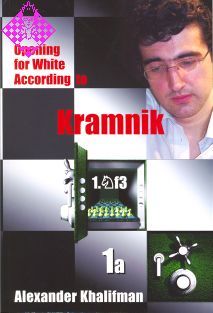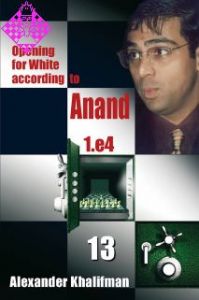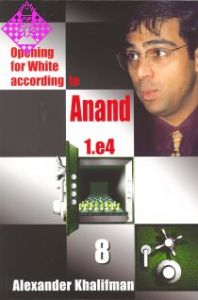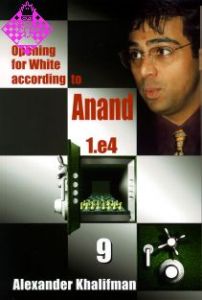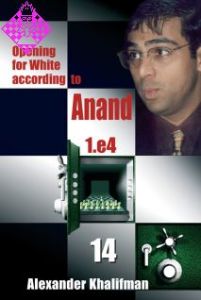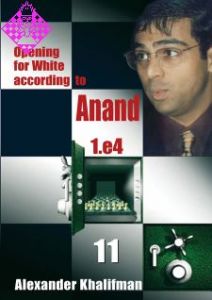Artikelnummer
LOKHA1SF3IA
Autor
1.Nf3 - Opening for White according to Kramnik 1a
Old Indian., King´s Indian Defence, Anti-Gruenfeld
308 Seiten, kartoniert, Chess Stars, 1. Auflage 2006
Aus der Reihe »Chess Stars Openings«
Final vergriffen
Concept of the Series
You are holding in your hands book one of the series "Opening for White According to Kramnik - 1.Nf3".
It is not exactly a book about openings, at least not in the generalaccepted fashion. It is not about the move 1.Nf3 and not about the Reti opening at all. This book is about how to solve your problems in the opening once and for all with the help of Vladimir Kramnik (who is a friend of mine and a co-author behind the scene...) under my supervision.
The idea to write that book came to my mind a long time ago. Chess players have always had the problem of a choice of openings and that is even more important in contemporary competitive chess. It is not a secret anymore that presently plenty of games are won thanks to the superior preparation of one of the players and mostly due to the correct choice of an opening. How to do that? How should one choose, what is appropriate for him, amidst an ocean of opening schemes, plans and variations?
One of the ways of solving that problem is to choose one of the leading contemporary grandmasters, whose style of playing suits you and whose successes you admire as the ideal model and to build up your opening repertoire based on his preference. There are some difficulties here, though... At first, it is who to choose as a pattern to imitate and secondly how to start playing the opening like your model? Naturally, you can select his games from the database and you can try to study them. Still, that is far from simple too. Your future opponent might be completely ignorant about the newest theoretical discoveries, played at the top level, and he might try at any moment some mediocre move, avoiding theory. Then, you will have to find yourself what to do next, what plan to follow and how to obtain the advantage.
Grandmasters do not just play certain openings. Their opening repertoire is the product of an entire concept. To put it in another way, every grandmaster uses a certain number of schemes that he knows well and he likes to play and he strives to follow them reachhis well familiar positions. (For example, whoever likes to play with Black the Queen's Gambit usually attempts to reach the typical lines of that opening after 1.c4 as well as after 1.Nf3.). Finally, every grandmaster has spent hundreds of hours on building his opening repertoire and he is ready to counter all possible surprises.
I suggest that you saved plenty of time and effort and I am ready to solve your opening problems for you when you play White. We will learn how to play openings "according to Kramnik". There is a catch here though... Kramnik's opponents are usually grandmasters and it would not come to their minds to make a very bad move, while your adversaries might easily do that and you will have then to react correctly yourselves. You will find the right solution of that problem in this book! In fact, this is a book about players who would like to play the opening like Kramnik, but whose opponents are expected to be slightly weaker than Anand and Topalov...
Whenever Kramnik begins his games with the move 1.Nf3, he does not intend to play the Reti opening at all. He simply wishes to obtain pleasant positions in case his adversary plans to choose the Queen's Indian Defence, the Gruenfeld Defence or the Benoni Defence.
The player who wishes to study (or to improve) the right way of playing the move 1.Nf3 with White, should not necessarily be a speof the Queen's Indian Defence and even less of the GruenDefence. After you have studied that book, you should always manage to enter well familiar positions (that is quite enjoyable...!) and you will feel comfortable if you know the standard strategical and tactical motives and ideas typical for that opening. You will also master how to obtain the advantage not only after Black's theoreticorrect play, but also whenever he plays inferior moves.
Meanwhile, it happens only very seldom that people who are bethe level of a master play closed openings. They usually consider the positions arising after 1.d4, or 1.c4 as very dull... They prefer starting with 1.e4 and after 1...e5, they like to analyze some exciting openings like the King's Gambit, the Evans Gambit etc...
Play 1.Sf3! and your inexperienced opponent might make a misright in the first several moves and then attack forcefully! Folmy recommendations, even if your adversary plays the opencorrectly, you will obtain positions with initiative and then it all depends on you. It is all in your head.
Preface
Dear readers,
We will analyze in the first part of our book the variations af1.Nf3 Nf6 2.c4 d6 3.d4 (The adherents to the first move with the queen's pawn should notice that we are back to the classics!). Strangely enough, in the Russian chess literature there is still not an officially accepted name of that not so fresh opening system yet. It might be named "not quite King's Indian Defence", or "almost King's Indian Defence". The Western school recognizes it as the Old Indian.
The point is that in this part of the book we deal with variations, in which Black delays the development of his bishop to g7, or he preit for another deployment altogether, for example after e7-e5 and Bf8-e7. In fact, these opening set-ups have long had the reputaof being solid, but with not so good prospects for Black. That is correct indeed, but White's task is far from simple, since he must choose between several promising lines. I hope that our book will help you solve that problem.
The second part of this book is in fact critical from the point of view of contemporary theory. It is devoted to a system, which has been named, not quite officially indeed, but still popularly - the "Anti-Gruenfeld". It is just one of the few "anti-systems", which we analyze in our series of books, so I would like to mention here again something about the general concept behind out multi-volume work "Opening for White According to Kramnik - 1.Nf3".
I recommend that you began your games with this knight-move, but that does not imply that you have to abandon the fight for the centre, or for the advantage in the opening. Actually, in the majority of cases, the game will soon transpose to lines that are quite typical for the players who usually start their games with the moves 1.d4 or 1.c4. However, there are some opening set-ups that we manage to avoid when we begin with the tricky development of the knight on move one. One of them is the Gruenfeld Defence and its present revival is mostly connected with the successes of Garry Kasparov.
Accordingly, after: 1.Nf3 Nf6 2.c4 g6 3.Nc3, Black follows with 3...d5, emphasizing that he does not intend to play the King's InDefence and he invites his opponent to enter the main lines of the Gruenfeld Defence. There follows however, an unusual move - 4.Qa4+!? and the Gruenfeld Defence is out of question and Black is faced with difficult problems. The theory of that system is relanew and players should be ready to start playing on their own as early as moves 7-8. I hope that I have managed to systematize in this book the accumulated practical material and to indicate the best prospects for White of obtaining the opening advantage. I believe that his chances to end up in a better position in the "Anti-Gruenfeld" are not worse at all than these in the main lines of that opening, while there is a greater opportunity of showing creative endeavour and imagination.
In the third part of this book, we begin to analyze the King's InDefence. Its main and most fashionable variations are so comand strategically independent that we have decided to devote a special volume to it (Book 1b). Still, some of the lines, which we deal with in this volume, deserve serious attention too. The majority of them are only seldom played in contemporary tournament practice, but the effect of surprise often justifies their use. I hope that similar surprises will more often bring you joy after you have studied our book thoroughly.
August 2006
A.Khalifman, 14th World Chess Champion
You are holding in your hands book one of the series "Opening for White According to Kramnik - 1.Nf3".
It is not exactly a book about openings, at least not in the generalaccepted fashion. It is not about the move 1.Nf3 and not about the Reti opening at all. This book is about how to solve your problems in the opening once and for all with the help of Vladimir Kramnik (who is a friend of mine and a co-author behind the scene...) under my supervision.
The idea to write that book came to my mind a long time ago. Chess players have always had the problem of a choice of openings and that is even more important in contemporary competitive chess. It is not a secret anymore that presently plenty of games are won thanks to the superior preparation of one of the players and mostly due to the correct choice of an opening. How to do that? How should one choose, what is appropriate for him, amidst an ocean of opening schemes, plans and variations?
One of the ways of solving that problem is to choose one of the leading contemporary grandmasters, whose style of playing suits you and whose successes you admire as the ideal model and to build up your opening repertoire based on his preference. There are some difficulties here, though... At first, it is who to choose as a pattern to imitate and secondly how to start playing the opening like your model? Naturally, you can select his games from the database and you can try to study them. Still, that is far from simple too. Your future opponent might be completely ignorant about the newest theoretical discoveries, played at the top level, and he might try at any moment some mediocre move, avoiding theory. Then, you will have to find yourself what to do next, what plan to follow and how to obtain the advantage.
Grandmasters do not just play certain openings. Their opening repertoire is the product of an entire concept. To put it in another way, every grandmaster uses a certain number of schemes that he knows well and he likes to play and he strives to follow them reachhis well familiar positions. (For example, whoever likes to play with Black the Queen's Gambit usually attempts to reach the typical lines of that opening after 1.c4 as well as after 1.Nf3.). Finally, every grandmaster has spent hundreds of hours on building his opening repertoire and he is ready to counter all possible surprises.
I suggest that you saved plenty of time and effort and I am ready to solve your opening problems for you when you play White. We will learn how to play openings "according to Kramnik". There is a catch here though... Kramnik's opponents are usually grandmasters and it would not come to their minds to make a very bad move, while your adversaries might easily do that and you will have then to react correctly yourselves. You will find the right solution of that problem in this book! In fact, this is a book about players who would like to play the opening like Kramnik, but whose opponents are expected to be slightly weaker than Anand and Topalov...
Whenever Kramnik begins his games with the move 1.Nf3, he does not intend to play the Reti opening at all. He simply wishes to obtain pleasant positions in case his adversary plans to choose the Queen's Indian Defence, the Gruenfeld Defence or the Benoni Defence.
The player who wishes to study (or to improve) the right way of playing the move 1.Nf3 with White, should not necessarily be a speof the Queen's Indian Defence and even less of the GruenDefence. After you have studied that book, you should always manage to enter well familiar positions (that is quite enjoyable...!) and you will feel comfortable if you know the standard strategical and tactical motives and ideas typical for that opening. You will also master how to obtain the advantage not only after Black's theoreticorrect play, but also whenever he plays inferior moves.
Meanwhile, it happens only very seldom that people who are bethe level of a master play closed openings. They usually consider the positions arising after 1.d4, or 1.c4 as very dull... They prefer starting with 1.e4 and after 1...e5, they like to analyze some exciting openings like the King's Gambit, the Evans Gambit etc...
Play 1.Sf3! and your inexperienced opponent might make a misright in the first several moves and then attack forcefully! Folmy recommendations, even if your adversary plays the opencorrectly, you will obtain positions with initiative and then it all depends on you. It is all in your head.
Preface
Dear readers,
We will analyze in the first part of our book the variations af1.Nf3 Nf6 2.c4 d6 3.d4 (The adherents to the first move with the queen's pawn should notice that we are back to the classics!). Strangely enough, in the Russian chess literature there is still not an officially accepted name of that not so fresh opening system yet. It might be named "not quite King's Indian Defence", or "almost King's Indian Defence". The Western school recognizes it as the Old Indian.
The point is that in this part of the book we deal with variations, in which Black delays the development of his bishop to g7, or he preit for another deployment altogether, for example after e7-e5 and Bf8-e7. In fact, these opening set-ups have long had the reputaof being solid, but with not so good prospects for Black. That is correct indeed, but White's task is far from simple, since he must choose between several promising lines. I hope that our book will help you solve that problem.
The second part of this book is in fact critical from the point of view of contemporary theory. It is devoted to a system, which has been named, not quite officially indeed, but still popularly - the "Anti-Gruenfeld". It is just one of the few "anti-systems", which we analyze in our series of books, so I would like to mention here again something about the general concept behind out multi-volume work "Opening for White According to Kramnik - 1.Nf3".
I recommend that you began your games with this knight-move, but that does not imply that you have to abandon the fight for the centre, or for the advantage in the opening. Actually, in the majority of cases, the game will soon transpose to lines that are quite typical for the players who usually start their games with the moves 1.d4 or 1.c4. However, there are some opening set-ups that we manage to avoid when we begin with the tricky development of the knight on move one. One of them is the Gruenfeld Defence and its present revival is mostly connected with the successes of Garry Kasparov.
Accordingly, after: 1.Nf3 Nf6 2.c4 g6 3.Nc3, Black follows with 3...d5, emphasizing that he does not intend to play the King's InDefence and he invites his opponent to enter the main lines of the Gruenfeld Defence. There follows however, an unusual move - 4.Qa4+!? and the Gruenfeld Defence is out of question and Black is faced with difficult problems. The theory of that system is relanew and players should be ready to start playing on their own as early as moves 7-8. I hope that I have managed to systematize in this book the accumulated practical material and to indicate the best prospects for White of obtaining the opening advantage. I believe that his chances to end up in a better position in the "Anti-Gruenfeld" are not worse at all than these in the main lines of that opening, while there is a greater opportunity of showing creative endeavour and imagination.
In the third part of this book, we begin to analyze the King's InDefence. Its main and most fashionable variations are so comand strategically independent that we have decided to devote a special volume to it (Book 1b). Still, some of the lines, which we deal with in this volume, deserve serious attention too. The majority of them are only seldom played in contemporary tournament practice, but the effect of surprise often justifies their use. I hope that similar surprises will more often bring you joy after you have studied our book thoroughly.
August 2006
A.Khalifman, 14th World Chess Champion
| EAN | 9789548782494 |
|---|---|
| Gewicht | 350 g |
| Hersteller | Chess Stars |
| Breite | 14,5 cm |
| Höhe | 21,5 cm |
| Medium | Buch |
| Erscheinungsjahr | 2006 |
| Autor | Alexander Khalifman |
| Reihe | Chess Stars Openings |
| Sprache | Englisch |
| Auflage | 1 |
| ISBN-10 | 9548782499 |
| ISBN-13 | 9789548782494 |
| Seiten | 308 |
| Einband | kartoniert |
| Name | Chess Stars |
|---|---|
| Adresse | Complex "Geo Milev" BL. 248 Ap. 47 Sofia 1113 Bulgarien |
| Internet | www.chess-stars.com |
| semkov@chess-stars.com |
007 Concept of the Series
009 Preface
Part 1. Old Indian Defence
1.Nf3 Nf6 2.c4 d6 3.d4
013 1 various; 3...Bf5
021 2 3.. Bg4
041 3 3...Nbd7 4.Nc3 c6 5.e4 e5 6.Be2 Be7 7.0-0 Qc7; 7...a6; 7...0-0 8.Be3 without 8...a6
065 4 3...Nbd7 4.Nc3 c6 5.e4 e5 6.Be2 Be7 7.0-0 0-0 8.Be3 a6
Part 2. Anti-Grunfeld Variation
1.Nf3 Nf6 2.c4 g6 3.Nc3 d5
090 5 4...c6; 4...Nc6
100 6 4...Bd7 5.Qb3 dc 6.Qxc4 without 6...a6
111 7 4...Bd7 5.Qb3 dc 6.Qxc4 a6
Part 3. King's Indian Defence
1.Nf3 Nf6 2.c4 g6 3.Nc3 Bg7 4.e4
121 8 4...c5; 4...e5
126 9 4...0-0 5.d4 c6
133 10 4...d6 5.d4 various
143 11 4...d6 5.d4 0-0 6.Be2 a5; 6...c6; 6...Nbd7; 6...Nc6
163 12 4...d6 5.d4 0-0 6.Be2 c5
175 13 4...d6 5.d4 0-0 6.Be2 Bg4 7.Be3 without 7...Nfd7
190 14 4...d6 5.d4 0-0 6.Be2 Bg4 7.Be3 Nfd7
207 15 4...d6 5.d4 0-0 6.Be2 e5 7.0-0 various
Part 4. King's Indian Defence
1.Nf3 Nf6 2.c4 g6 3.Nc3 Bg7 4.e4 d6 5.d4 0-0 6.Be2 e5 7.0-0 Nbd7 8.Be3
240 16 various; 8...a5; 8...h6
249 17 8...exd4
259 18 8...Se8
269 19 8...Qe7
282 20 8...Ng4
293 21 8...c6
304 Index of Variations
009 Preface
Part 1. Old Indian Defence
1.Nf3 Nf6 2.c4 d6 3.d4
013 1 various; 3...Bf5
021 2 3.. Bg4
041 3 3...Nbd7 4.Nc3 c6 5.e4 e5 6.Be2 Be7 7.0-0 Qc7; 7...a6; 7...0-0 8.Be3 without 8...a6
065 4 3...Nbd7 4.Nc3 c6 5.e4 e5 6.Be2 Be7 7.0-0 0-0 8.Be3 a6
Part 2. Anti-Grunfeld Variation
1.Nf3 Nf6 2.c4 g6 3.Nc3 d5
090 5 4...c6; 4...Nc6
100 6 4...Bd7 5.Qb3 dc 6.Qxc4 without 6...a6
111 7 4...Bd7 5.Qb3 dc 6.Qxc4 a6
Part 3. King's Indian Defence
1.Nf3 Nf6 2.c4 g6 3.Nc3 Bg7 4.e4
121 8 4...c5; 4...e5
126 9 4...0-0 5.d4 c6
133 10 4...d6 5.d4 various
143 11 4...d6 5.d4 0-0 6.Be2 a5; 6...c6; 6...Nbd7; 6...Nc6
163 12 4...d6 5.d4 0-0 6.Be2 c5
175 13 4...d6 5.d4 0-0 6.Be2 Bg4 7.Be3 without 7...Nfd7
190 14 4...d6 5.d4 0-0 6.Be2 Bg4 7.Be3 Nfd7
207 15 4...d6 5.d4 0-0 6.Be2 e5 7.0-0 various
Part 4. King's Indian Defence
1.Nf3 Nf6 2.c4 g6 3.Nc3 Bg7 4.e4 d6 5.d4 0-0 6.Be2 e5 7.0-0 Nbd7 8.Be3
240 16 various; 8...a5; 8...h6
249 17 8...exd4
259 18 8...Se8
269 19 8...Qe7
282 20 8...Ng4
293 21 8...c6
304 Index of Variations
Mehr von Chess Stars
-
 The Modern English vol. 1 + 239,90 €
The Modern English vol. 1 + 239,90 € -
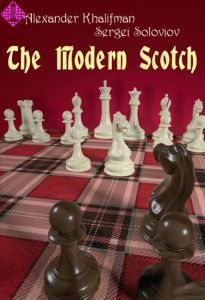 The Modern Scotch23,95 €
The Modern Scotch23,95 € - Mehr von Chess Stars

